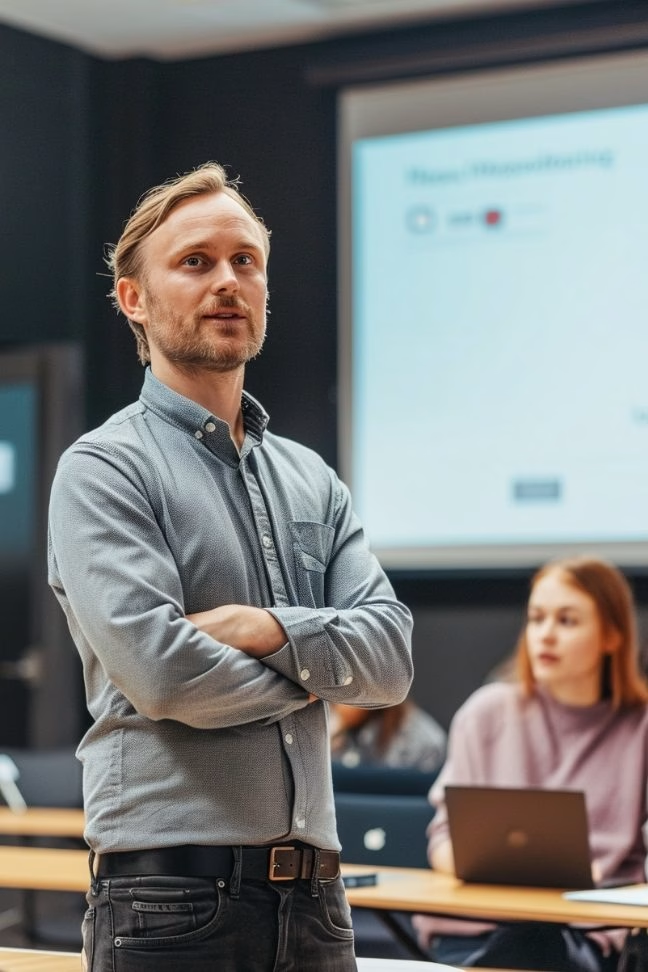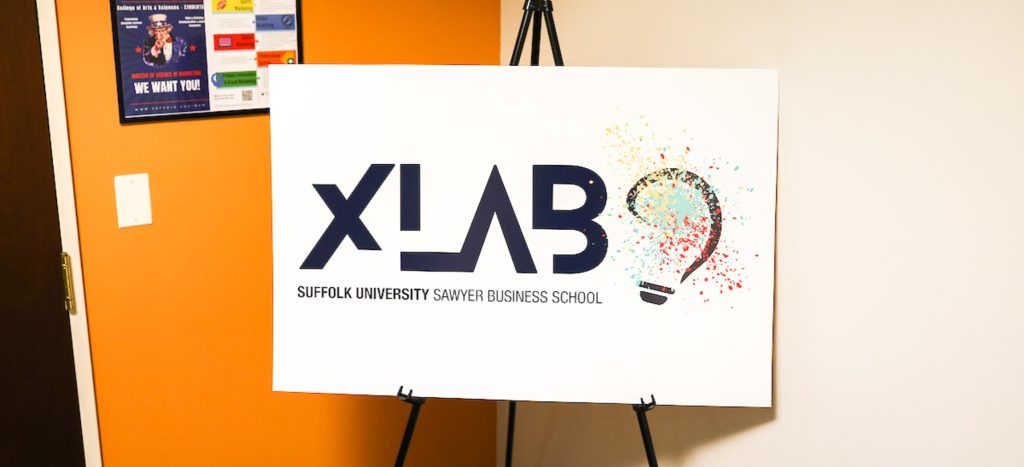Suffolk University’s X-Lab at Sawyer Business School, equipped with iMotions’ cutting-edge biosensor research platform, enables in-depth human behavior studies. Dean Amy Zeng and Dr. Jane Zhu share insights into the lab’s creation, challenges, and alignment with strategic goals, which have made it a success for students, faculty, and the university.
Table of Contents
- Why did you want to establish a human behavior research lab, and what was your initial vision?
- How did you get support for the development of the X-Lab?
- What were some of the challenges or objections you faced when first proposing the lab, especially considering that the initial proposal was denied?
- Can you share which pillars of your strategic plan this initiative aligns with, and how that alignment helped make the case for the lab?
- How do you fund the lab?
- What other efforts are you planning to help promote the lab and encourage more faculty and students to use it?
- Why are innovations like this important to integrate into education?
Nearly two years ago, Suffolk University opened the X-Lab at Sawyer Business School to provide students and faculty with the opportunity to conduct in-depth human behavior research. The on-campus space features iMotions’ leading biosensor research platform, including multimodal technology to capture eye metrics and facial expressions. The lab has been a resounding success for students, faculty, and the university itself.

In the following Q&A, Dr. Amy Zeng, Dean of the Sawyer Business School, and Dr. Jane Zhu, Chair of the Marketing Department, discuss the establishment and vision behind the X-Lab, including motivations for creating a human behavior research lab, the challenges faced in gaining support, and the strategic alignment that ultimately led to the lab’s success.
Why did you want to establish a human behavior research lab, and what was your initial vision?
Amy Zeng: I first learned about eye-tracking technology during my time as a faculty member at Worcester Polytechnic Institute (WPI) about 10 years ago. When I became Dean of the Sawyer Business School at Suffolk University, I started thinking about how to enhance the competitiveness of our school. We decided to focus on immersive learning as a core educational approach. When Dr. Mujde Yuksel in the Marketing Department proposed starting a neuroscience marketing lab, the idea resonated with me immediately, particularly because of my previous exposure to eye-tracking technology at WPI.
How did you get support for the development of the X-Lab?
Zeng: For any significant decision or investment, it’s important to align the initiative with our strategic plan. I start by reviewing our initiatives and my vision for the school, which helps convince various stakeholders. We also involve the disability office to ensure the lab is accessible to all learners as part of a comprehensive governance process. By articulating the alignment between the lab and our strategic goals—such as faculty excellence, enhanced educational outcomes, and brand recognition—we’ve gained support. Finding the necessary funding is the other major challenge; as the leader of the school, I had to ensure that any investment was aligned with our strategic initiatives. But once everything is aligned, it becomes easier to move forward.
What were some of the challenges or objections you faced when first proposing the lab, especially considering that the initial proposal was denied?
Jane Zhu: As believers in neuroscience technology, we found it a no-brainer. However, during our introductory sessions with alumni or board members, many raised questions—especially those working in marketing or business intelligence. They were concerned about the ethics of using technology to gather biometric information. Questions about privacy, data protection, and the ethical use of consumer insights were common. Once we established clear protocols and demonstrated our commitment to ethical research, we were able to alleviate those concerns and gain support from internal and external stakeholders. Another significant concern was financial. Gaining support from school leaders at all levels was the key to the establishment of the lab, especially in its early stage.
Can you share which pillars of your strategic plan this initiative aligns with, and how that alignment helped make the case for the lab?
Zeng: The X-Lab supports all four of our strategic initiatives. First, it enhances faculty excellence by providing new tools for research and fostering interdisciplinary collaboration. Second, it improves educational experiences by expanding and enhancing students’ skills, for example in analyzing emotions. Third, it increased educational outcomes, including enhanced AoL results, greater student participation in research projects, increased job placements, and new interdisciplinary academic offerings.
We are currently discussing a new joint graduate degree in UX/UI with the College of Arts and Sciences, where the X-Lab will support the practicum in the curriculum. Fourth, the lab helps in brand recognition, strengthening our position as a leader in immersive education and demonstrating our expertise in developing industry partners to help extend learning horizons. For instance, our X-Lab and iMotions jointly presented a special session on using biometrics in researching and teaching consumer behaviors at the American Marketing Association Educators’s Summer Conference this month. Aligning the lab with these pillars made gaining buy-in and securing funding easier.
How do you fund the lab?
Zeng: We received financial and tech support from our University’s ITS Office and also funded part of the development of the lab through the Dean’s Initiative Fund, the school’s operating budget, and personal donations. Now that the lab is operational and producing results, we are seeing increased buy-in and hope to attract more alumni and donor support. As we look to scale, it’s important to elevate its reputation and visibility among key stakeholders. Future plans include adding more stations and increasing campus-wide adoption.

Zhu: To support these initiatives, we do a number of things. One, we invited faculty from different disciplines and other schools to our grand opening event. To prepare for faculty adoption of the technology, we sent faculty members to the academic iMotions training. Two, we host tours for potential donors and industry clients, with the long-term goal of securing naming rights and establishing an endowment to sustain the lab’s operations and further development.
We also host tours for the Dean’s Cabinet and for our school alumni association board members to showcase its value and impact. Three, we seek research or industry-based projects where we can produce meaningful research findings and attract funding from companies. Four, we engage students in the lab operation from the very beginning. We recruit undergraduates and master program students as lab assistants. A subject pool was set up for business students to experience the technology as research subjects. We even include the lab as a stop on the student recruitment tour so prospective students can see our advanced technologies. .
Zeng: It’s also important to have leaders within who champion the lab. We are fortunate to have champions like Professor Yuksel, who is now the Director of the X-Lab, along with researchers like Jane and other marketing faculty who are very knowledgeable about this technology. They are crucial in promoting the lab to other faculty members who are often unaware of the lab’s background or its benefits.
What other efforts are you planning to help promote the lab and encourage more faculty and students to use it?
Zhu: We plan to host more events, such as research symposiums and demonstrations, to showcase the lab’s capabilities to faculty across the campus. This will allow more people to learn about the lab and become part of the effort. Additionally, our school offers teaching and research grants, which can guide faculty in considering new projects that could involve the X-Lab.
We also try to find various ways to promote the lab, such as including X-Lab achievements in the Dean’s newsletters, seminars, or conferences we host. Last fall, for instance, we hosted the Northeast Business Deans Association Conference and organized a session on immersive learning where we talked about the X-Lab.
Why are innovations like this important to integrate into education?
Zhu: This technology represents the future, which is the marriage between science and art in the marketing field. Our foundational knowledge in marketing often only scratches the surface of what drives consumer behavior. Traditional consumer research relies heavily on surveys and observations, but these methods don’t always capture the underlying neural processes influencing decisions. The X-Lab pushes the boundaries by providing tools that allow us to explore how messages are truly perceived in the mind.
In my research, I’ve seen leading scholars publish in top journals using this kind of technology. It’s essential for all of our students, as future professionals in marketing, to experience these tools. They may not reach that kind of a high expert level, but familiarizing themselves with user-friendly technologies like iMotions will enable them to confidently interpret and apply neuroscience data.
You can read more about the opening of the Sawyer Business School X-Lab here:
iMotions EduLabs
Where academia meets application
- Engage students with hands-on research experience
- Expand research with cutting-edge technology
- Encourage collaboration and innovation on campus
- Explore new opportunities to connect with your community








